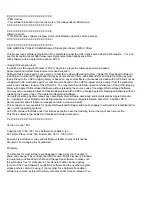
MegaRAID SAS Software User
Guide
2-1
Chapter 2
Introduction to RAID
This chapter describes RAID (Redundant Array of Independent Disks),
RAID functions and benefits, RAID components, RAID levels, and
configuration strategies. In addition, it defines the RAID availability
concept, and offers tips for configuration planning.
2.1
RAID Description
RAID is an array, or group of multiple independent physical drives that
provide high performance and fault tolerance. A RAID drive group
improves I/O (input/output) performance and reliability. The RAID drive
group appears to the host computer as a single storage unit or as
multiple virtual units. I/O is expedited because several drives can be
accessed simultaneously.
2.2
RAID Benefits
RAID drive groups improve data storage reliability and fault tolerance
compared to single-drive storage systems. Data loss resulting from a
drive failure can be prevented by reconstructing missing data from the
remaining drives. RAID has gained popularity because it improves I/O
performance and increases storage subsystem reliability.
2.3
RAID Functions
Virtual drives are drive groups or spanned drive groups that are available
to the operating system. The storage space in a virtual drive is spread
across all of the drives in the drive group.
Содержание ThinkServer RD230
Страница 1: ...ThinkServer RD230 RD240 and TD230 MegaRAID SAS Software User Guide ...
Страница 2: ......
Страница 3: ...ThinkServer RD230 RD240 and TD230 MegaRAID SAS Software User Guide ...
Страница 16: ...Contents ...
Страница 24: ...Contents ...
Страница 68: ...2 36 Introduction to RAID ...
Страница 252: ...7 10 MegaRAID Storage Manager Window and Menus ...
Страница 262: ...8 10 Configuration Figure 8 5 Virtual Drive Creation Menu The dialog box shown in Figure 8 6 appears ...
Страница 300: ...8 48 Configuration ...
Страница 328: ...9 28 Monitoring System Events and Storage Devices ...
Страница 334: ...10 6 Maintaining and Managing Storage Configurations ...
Страница 360: ...B 12 Glossary ...
Страница 363: ......
Страница 364: ......
















































